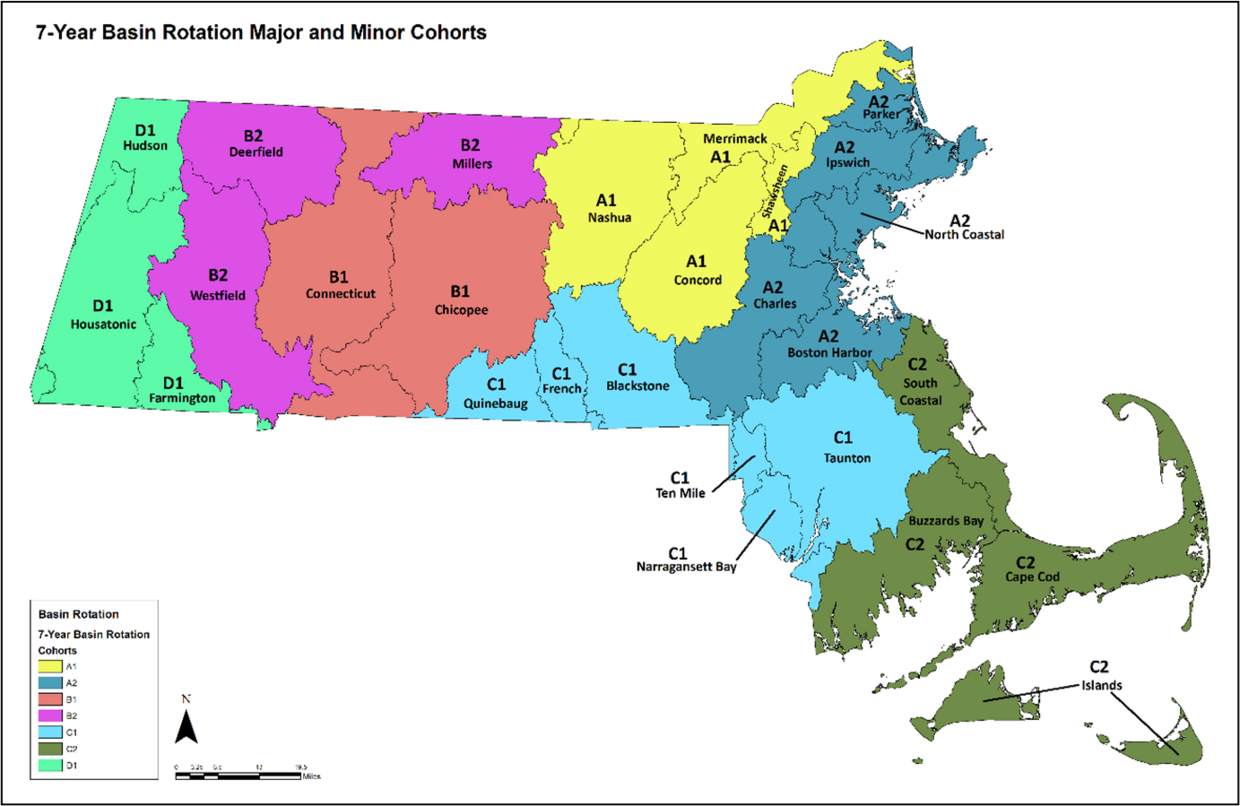The goal of MAP2 is to provide an assessment with a known statistical confidence as to whether certain designated uses (e.g., aquatic life, recreational, aesthetics) are supported in MA waters and the potential stressors affecting those uses. Wadable rivers and streams were assessed from 2011 through 2015; followed by a survey of lakes and ponds from 2016 - 2018. A four-year assessment of coastal and estuarine waters was initiated in 2020 and will continue through 2023. WPP plans to continue these surveys to evaluate long-term water quality trends and to assess the effectiveness of water quality management programs.
Rivers and Streams (2011-2015)
The MAP2 network of 177 wadable (i.e., 1st – 4th Strahler Order), freshwater perennial streams allows for the determination of the percentage of stream miles supporting their designated uses in Massachusetts. The streams were divided into five groups: 1) “Central”; 2) “West”; 3) “Southeast”; 4) “Midwest”; and 5) “Northeast”. Each group was monitored in a single year which resulted in the completion of the statewide sampling program over five years. WPP collected the following data: nutrients (total phosphorus, total nitrogen, nitrate-nitrite and ammonia), turbidity, true color, E. coli bacteria, chloride, dissolved heavy metals, pH, specific conductance, continuous temperature, continuous dissolved oxygen, benthic macroinvertebrate community, fish community, habitat assessment, and aesthetics observations. Find results that were published in a final report.
Lakes and Ponds (2016-2018)
This MAP2 network enables an unbiased assessment as to whether the aquatic life, recreational, fish consumption, and aesthetic uses of lakes and ponds are supported statewide. The survey design was based on a computer-generated random selection of waterbodies. The major Massachusetts river basins were divided into three groups (i.e., “West”, “Northeast” and “Southeast”), each containing approximately 25 lakes. The survey focused on one region each year over three years sampling a total of 79 lakes. The following water quality and ecological variables were measured:
- Deep hole: Vertical profile (dissolved oxygen, temperature, pH, conductivity), Secchi disk transparency, nutrients (total phosphorus, total nitrogen), water chemistry (true color, alkalinity, hardness, turbidity, dissolved silica, chloride, dissolved organic carbon), chlorophyll a, and phytoplankton community (including diatoms)
- Shoreline: Pathogens (E. coli), cyanobacteria, and algal toxins (microcystins and anatoxin-a)
- Whole lake: Littoral macroinvertebrate community, fish tissue (mercury organochlorine pesticides, metals), macrophytes (percent cover, biovolume, non-native species), bathymetry, human disturbance observations, aesthetics observations
WPP is evaluating data from the lakes and ponds survey and will assess the waterbodies in accordance with the Massachusetts Consolidated Assessment and Listing Methodology (CALM) Guidance Manual.
Coastal and Marine Waters (2020-2023)
In 2019, the Massachusetts Coastal Condition Assessment, or MCCA was designed to provide an unbiased assessment of the condition of coastal and marine waters and determine the percentage of these waters supporting the aquatic life use. In addition, the MCCA will establish a baseline to measure future trends in conditions. The MCCA is administered collaboratively by WPP and the Massachusetts Bays National Estuary Partnership (MassBays). The pilot study began in 2020 consisting of 15 sampling sites. From 2021 – 2023, a minimum of 25 sites were selected for sampling each year in different geographic regions of the Massachusetts coastline which, including the pilot year, will result in a total of 90 sites statewide. At the completion of the survey, a final report will be prepared. Field crews record ambient conditions, collect water column profile data and water and sediment samples, assess the benthic infauna community, and record the presence/absence of eelgrass at each site once per month from June through September as listed below:
- Water: Hydrographic profile (dissolved oxygen, temperature, pH, salinity, turbidity), light attenuation/photosynthetic active radiation (PAR), Secchi disk transparency, nutrients (total phosphorus, orthophosphate, total and dissolved nitrate-nitrite, ammonia, total Kjeldahl nitrogen, total nitrogen), and Chlorophyll a.
- Sediment: Grain size, total organic carbon, chemistry (metals, mercury, polycyclic aromatic hydrocarbons (PAHs), polychlorinated biphenyls (PCBs), organochlorine pesticides), and toxicity (estuarine amphipod, Leptocheirus plumulosus)
- Biological: Benthic macroinvertebrates and submerged aquatic vegetation
